I know I’m late to the party with this one, but it would be a shame to not review the RG350M. Some of the recent reviews on this site haven’t been what you would call glowing, and it’s rare that you come across a handheld quite as good as this. So to prove I’m not just an old stick in the mud who likes to whinge, have a read of some nice things I have to say in the Anbernic RG350M review.
There’s nothing new in this product really, the RG350M is basically the same machine as the RG350 released last year. But it’s had a couple of iterations since then, including a metal variant of the original design. The RG350M is the third in a family of four versions of this machine, the fourth being the soon to be released RG280M.
- RG350 – September 2019
- RG350 Metal – November 2019
- RG350M – March 2020
- RG280M – July 2020
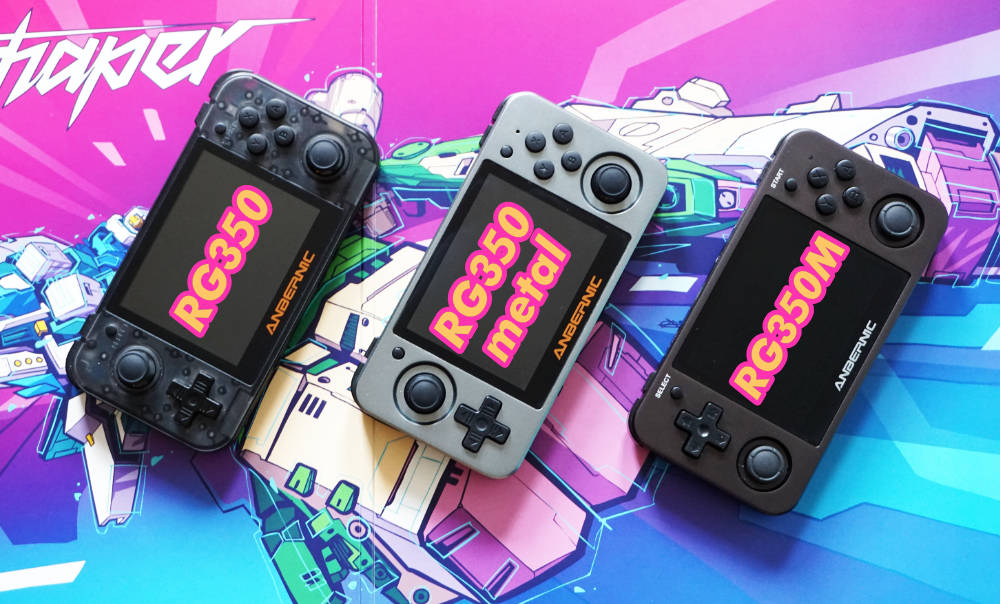
IMPROVEMENTS ON THE DESIGN
The RG350M takes the metal shell concept from November 2019 and improves upon it massively. The motherboard has had a complete re-think, moving various buttons and ports to better positions on the shell. Both SD cards are now accessible externally and the dpad and analog stick placements are swapped. In fact the analog sticks have been completely replaced for wider, low profile ones too. And to top it off, that low resolution 320×240 LCD has been replaced for a 640×480 one. Not just that, it’s apparently been laminated too, so the clarity is really good. A full list of changes to the original design are below.
- The dpad position has been swapped with the left analog stick.
- Both SD cards are now accessible without dismantling the device.
- The LCD has been replaced for a 640×480 OCA laminated one.
- Both analog sticks are now low profile versions, which protrude far less distance from the shell.
- The power button is now on the right hand side of the shell.
- The volume rocker is now on the left hand side of the shell.
- Silicon grips have been added to the back plate.
If you compare this shell to that of the RG350 Metal, you can see that it’s a complete re-design. The Metal RG350 was really chunky, a good 4mm fatter than the original RG350. The RG350M on the other hand is barely any bigger at all. Maybe a millimetre fatter than the original plastic design I reckon, in the absence of calipers. RG350M on the left, RG350 Metal on the right.

CONTROLS
First things first, the new analog sticks are nothing short of dreamy. They sit flush to the rest of the controls, and have a larger surface area than before. They’re very nice to use. Unlike the previous sticks, these do not have rubber caps, they’re moulded from one solid piece of rubberised plastic. I’m pretty sure they’re the same as or clones of the Switch analog sticks, but don’t quote me because I don’t have a Switch.
Likewise the dpad is a shining example of how a dpad should be done. Whilst there was not much to complain about on the previous two versions, the dpad on the RG350M is much better. There is no mushiness at all, it has a perfect pivot and the indented ridges of the previous design have been removed. And of course, the placement is better for those of us with bigger hands now that it’s up top.
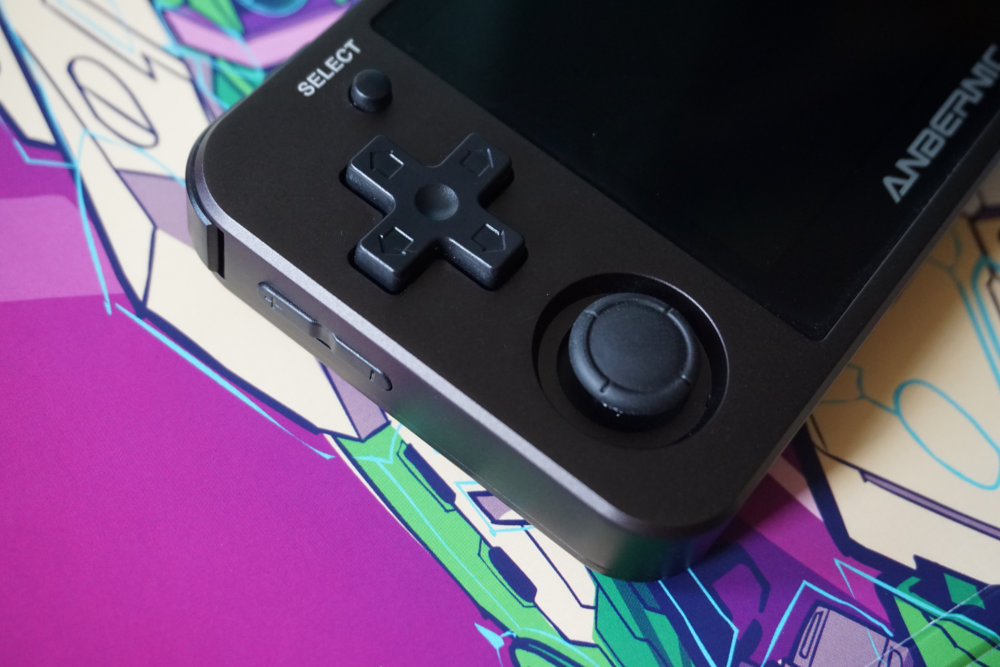
The rest of the controls are pretty much the same, that is to say they’re really very good. All four triggers are easily reached and click softly when pushed from any angle. The start and select buttons are slightly taller than they were in the previous Metal version too, so you don’t need to get your finger nail on them to press them in.
LCD
As previously mentioned, the LCD is now a laminated 640×480 IPS display. Comparing devices side by side, it’s really obvious to see. The difference doesn’t really come out very well on camera, but believe me that in person the new display is so crisp and clear that it’s hard to see how we put up with 320×240 for so long. The colour temperature is slightly more warm/pink on the RG350M, which I prefer to the blueish hue of the previous models. A full resolution version of the the below image can be found here.
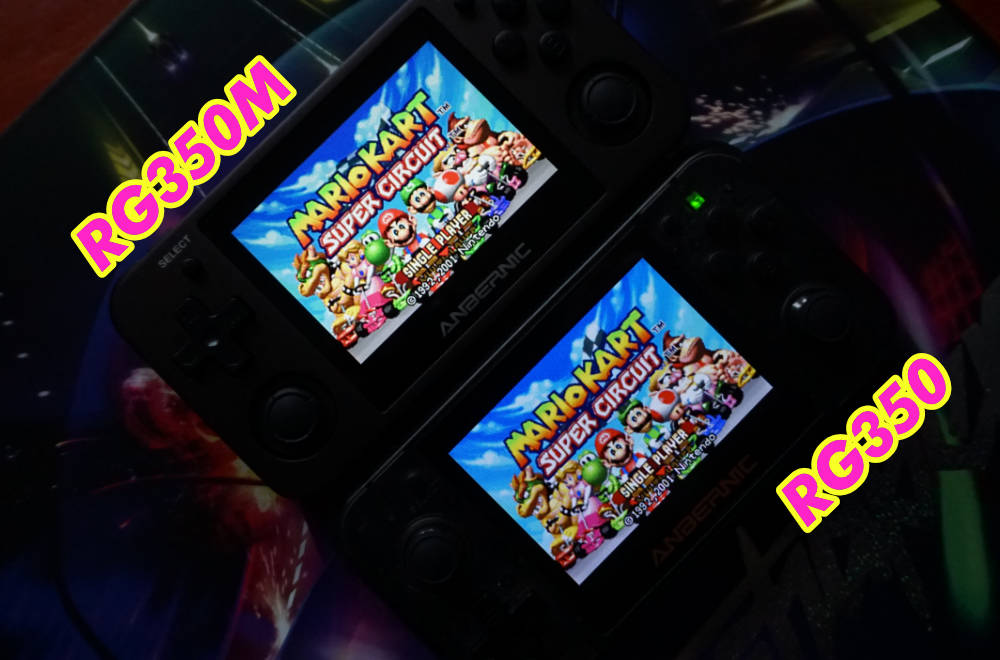
The biggest giveaway that the RG350M has a new LCD though is the lack of any pixel grid. It’s weird that I never really noticed it before but it’s really obvious on the previous models now. There’s no visible pixel grid on the RG350M, it is bright and colourful and the viewing angles are exceptionally good. There is no inversion or fading of colours at any angle, all the way down to 180 degrees in any direction. Whilst multiples of 320×240 don’t play very nicely with GBA, there is a definite improvement in clarity when viewed on a 640×480 screen. Of course you’ll never get as crisp an image for GBA as you do on the RK2020 or Odroid-Go Advance with its perfect integer scaling, but it is better now than it was on previous devices.

PERFORMANCE
The RG350M contains the same JZ4770 CPU found in the following other handhelds:
- GCW Zero
- RG350
- RG350 Metal
- New PocketGo V2 (aka PocketGo v2)
- Variants of the PocketGO v2 such as the PlayGo and Miyoo Max
- RG280M
You can expect very good emulation of all consoles up to and including the PlayStation 1. But emulation isn’t all it can do. OpenDingux is built on Linux, so there are plenty of ported games available for it too. Just have browse through this repository, the library is extensive!
OPERATING SYSTEMS
The shipped system is a OpenDingux, and it comes pre-loaded with a ton of emulators, games and ports. There was only one 16GB SD card in mine, and it also came pre-loaded with thousands of ROMs. Strangely, lots of them are ROM hacks, and they’re all numbered so it’s impossible to find anything alphabetically. I’ve deleted them all and loaded my own.
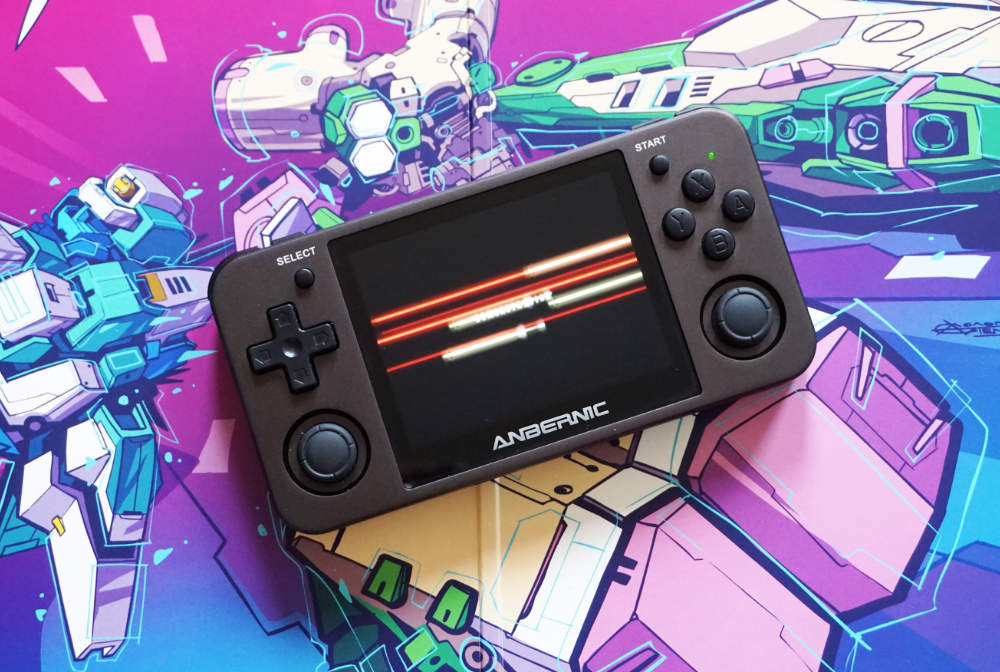
As I type, the ROGUE firmware has just been updated and released for the RG350M. You can download this replacement OS courtesy of Ninoh-FOX from here. Be aware that if your RG350M only came with one SD card, then flashing a new OS will wipe out all your ROMs and saves. Back them up if you need to.
BUILD QUALITY
It’s no exaggeration to say that the RG350M has the best build quality of any Chinese handheld I’ve ever owned. I’m not saying that frivolously because it’s made of metal, it is incredibly impressive how well designed and assembled it is. The previous metal version of the RG350 did have its problems. People reported the analog sticks getting stuck, or shoulder buttons not quite clicking properly. That’s because all Anbernic did was take the RG350 board and buttons and put them in a metal shell, with different tolerances. The RG350M has had a complete overhaul to accommodate its new casing, and it really shows.
You could easily mistake it for a product from one of the big boys, apart from the fact they’d never consider building a handheld from metal because it’s too expensive.
SHOULD YOU BUY AN RG350M?
We are in an era of higher powered ARM based handhelds now, whether that be Android or Linux based machines. Gamers rightfully expect to be able to emulate consoles like the PSP, N64 and Dreamcast on their handhelds these days. Whilst it’s true that other machines can handle some of that, it is really touch and go whether you’ll get the performance from any given game.
There’s something quite comforting about knowing with some certainty that whatever you want to play on the RG350M will probably work just fine, within its limitations. And I would say that OpenDingux is a far superior system to any of those available for the Odroid-Go Advance or RK2020. It has had many many years of polishing, it’s customisable, stable, straightforward and overall a pleasure to use.

The RG350M is the flagship JZ4770 handheld. It took a few attempts for Anbernic to get there, but they really did it in end. It’s hard to find much to criticise it for, but if pushed I would say that it is heavy. At roughly 250g, it’s a good 85g heavier than the original plastic version. It’s the metal that makes it what it is though, it looks and feels rock solid and it screams ‘premium product’ from every angle. Anbernic learned from their first attempt, and improved upon it in almost every way. Credit to them.
The RG350M is available all over the place now, if you’re after one then I would just go wherever they’re cheapest on the day.
HEADS UP
I should probably say here that I paid in full for my RG350M, it wasn’t donated for review. Not that it makes any difference to the way I review something. If you’re sensing shenanigans by my outrageous positivity, then rest assured it is because I am genuinely impressed. If you prefer the articles with more whinging and criticism, then just you wait for the PowKiddy V90 review 😀
As usual, if you use a link on this site to make a purchase, I get a few cents towards the upkeep of this site. It doesn’t cost you anything and it’s much appreciated.


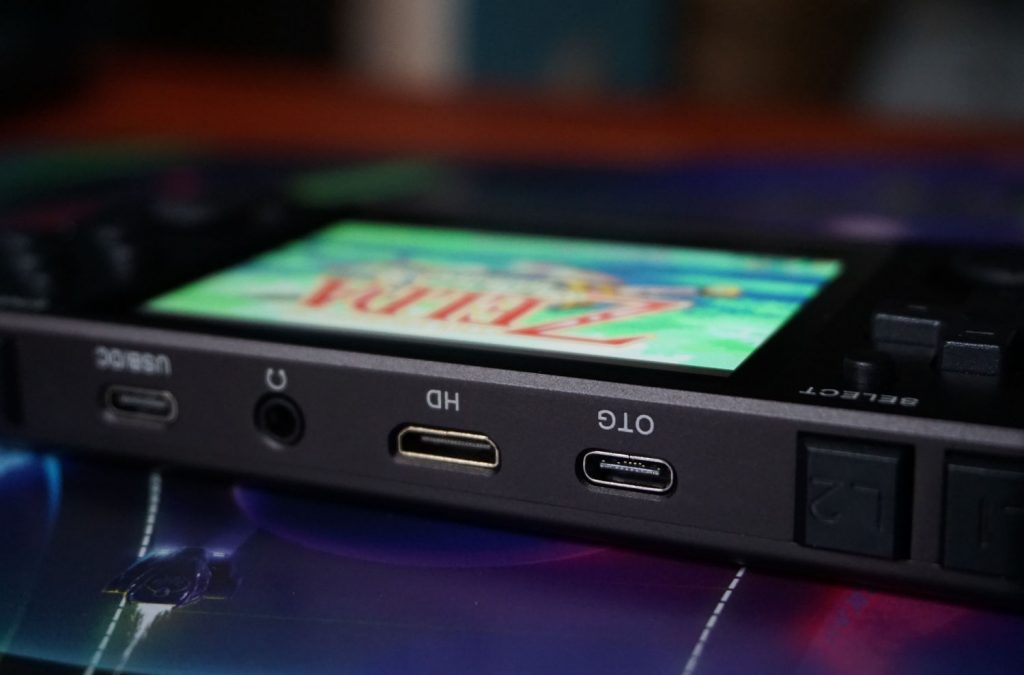
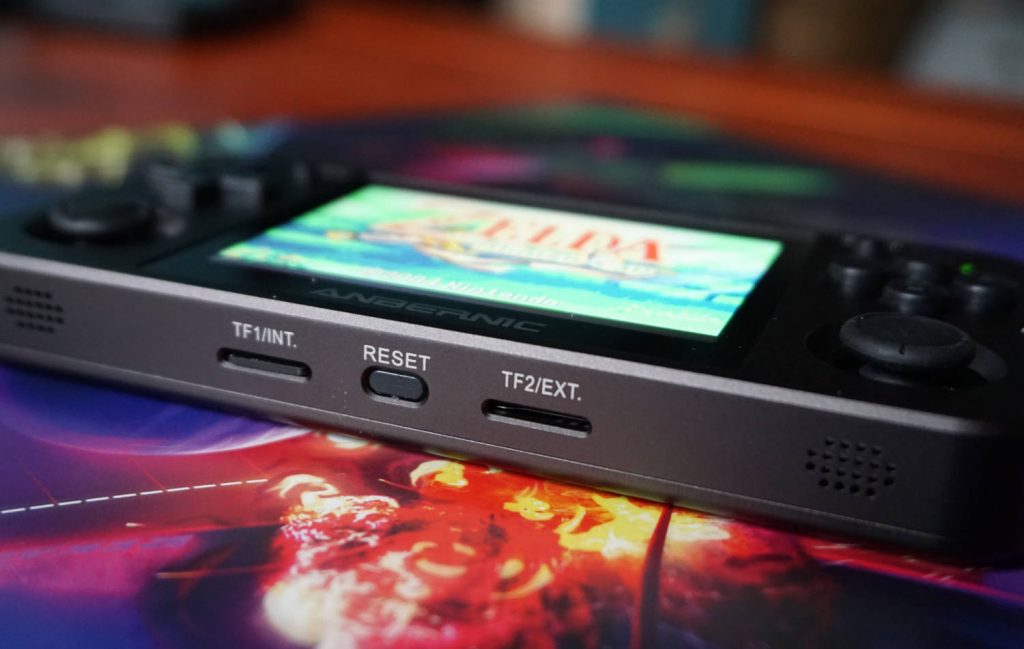
Can an external controller be plugged in for 2 player games?
After seeing multiple reviews – including yours – I finally just pulled the trigger on buying mine in another tab. Now the wait begins. I’m not very savvy with setting up my own stuff, but this sounds incredibly straight-forward – just a matter of popping out the external card, popping it on the computer, and adding/removing ROMs as I desire. Doubt I’ll get to heavy into adding or subtracting emulators or anything, but we’ll see just how brave I get. Thanks for the great review!
I’m interested in what you say about Open Dingux being preferable to what you can run on OGA-likes. Is the performance unreliable with PS1-and-below with those images? I only have a PGv2 but I’ve been eying OGA clones.
The OGA-likes run up to PS1 perfectly, but it’s the systems above that which are sometimes flakey.
Well it turns out that software on the 350M has a bunch of issues.
I’ve found a bunch of hardware scaling issues in several emulators: PCSX4All, FBA, Fceux… Either the hardware scaling code needs some fixing or these emulators will need to be specifically modified, which seems a hassle for developers.
I feel a bit disappointed personally. A real shame because the enhanced control placement and the really nice build quality are extremely pleasant.
Also the extreme clarity of the screen is not so flattering for retro games, especially without any filtering.
I’m considering to return it, since I’ve kept my regular RG350.
What do you mean exactly regarding the scaling issues? I haven’t noticed anything strange outside of the usual resolution discrepancies.
If you do a bit of research you can figure out where to get everything needed without the Play Store. It’s all about risk level…random website with the files needed or go through Google.
I keep my WiFi off 99% of the time (since we’re not getting updates anyway) and the programs I use I’d rather just go direct to the source and download the apk files from the dev and install/patch myself.
The GPD does a fantastic job for what it is, I use it during breaks at work and routinely get 3-4 days at a time ~8 hrs battery life which is great imo for a used unit.
I don’t have Clean Rom, I’m enjoying the system/performance enough as-is and it’s literally been years since I rooted anything…I’m so out of practice I’m afraid I’d botch it all up and the minor speed increase doesn’t seem worth the trouble of reduced battery life + increased heat.
Very detailed review. Does this chip run aswell as the RK/Odroid Mame, SNES (special chip games included) and GBA?
I’m thinking about picking one of these up myself, and I’m torn between the black and the silver aluminum. Does the black aluminum pickup a lot of smudges and fingerprints?
The dark grey version physically rejects fingerprints. I only had to clean the screen before taking photos of it for this review.
I just realize there’s a “metal” and a “M” version of this thing! I always thought they were the same, and almost bought a “metal” by mistake. Thank you for placing the three side by side on first photo
I’m not the first person who’s said this and I probably won’t be the last, but in terms of design/layout/materials, this thing is basically perfect for what it is. If they would put a decent newer SOC in it, it would be untouchable. They could iterate on that without making any other changes for many years and remain best in class. As it is, it’s very nice, but the relatively weak performance makes it tough to recommend at the price.
I totally agree, the design and execution is about as good as it can get. As for the price, check out the banggood link. $90 is pretty reasonable I would say. I do hope they use this design for future, more powerful handhelds.
Fantastic review, I just wish there was a bit more power to go with the improved resolution, controls and case. I’d have bought this without a second thought if the chipset could handle DC/PSP (I know, redundant since the PSP is already portable) titles.
As it is, I went with a GPD XD Plus for $160 on eBay and after some slight customization it runs like a champ and I can get ~3-4 days solid gaming with it when I get breaks.
Thanks for the review!
Thanks man. Yep the XD+ really stands up even today, it’s a great machine. I need to grit my teeth and get CleanROM installed on it at some point.
Genuine concern. I’ve always thought OpenDingux’s biggest omission from a handheld gaming POV is the lack of a Sleep/Resume feature. I’m not sure I can go without that. What are your thought’s on this having used the device?
It takes less than 10 seconds to boot up so it doesn’t bother me really. It would be a useful feature tho.
The Rogue firmware has this feature I believe
I believe the Rogue custom firmware has this feature
Are there any retro gaming handhelds that DO support sleep/resume?
Many OGA Images already do. Anything Android bested will – like the Game kiddy models, GPD XD Plus etc… Also if you go for modded PSP/go, PS Vita etc… they all do it perfectly. It’s just Opendingux that doesn’t really.
Thanks for your reply. Looks like the out-of-the-box OGA doesn’t support it, but I guess it’s not that hard to use an alternate image. The RK2020 is looking a lot more tempting now. OGA is my first choice, but I don’t have much faith in my ability to actually get one.
GPD XD and XD Plus (slightly beefier specs on the Plus)
It’s Android and while it does run a somewhat outdated piece in 7.0 it has some customization options and runs everything up to DC/PSP titles fairly well. PSP I’ve been particularly impressed with running most titles at locked FPS with v-sync, AA and 2x resolution.
Don’t you need wifi and Google Play store access to use the GPD XD? I don’t mind an outdated version of Android if I don’t have any personal information on it, but if I have to log into the Google Play store it seems very risky. I thought about it over the years and decided it’s just not safe in the current security environment.
If you do a bit of research you can figure out where to get everything needed without the Play Store. It’s all about risk level…random website with the files needed or go through Google.
I keep my WiFi off 99% of the time (since we’re not getting updates anyway) and the programs I use I’d rather just go direct to the source and download the apk files from the dev and install/patch myself.
The GPD does a fantastic job for what it is, I use it during breaks at work and routinely get 3-4 days at a time ~8 hrs battery life which is great imo for a used unit.
I don’t have Clean Rom, I’m enjoying the system/performance enough as-is and it’s literally been years since I rooted anything…I’m so out of practice I’m afraid I’d botch it all up and the minor speed increase doesn’t seem worth the trouble of reduced battery life + increased heat
Do you recommend this device over the RK2020?
Hi, nice review! With Rogue CFW now compatible, I’m nearly sold. Taki Udon’s review mentioned a lower battery life compared to the regular RG350. What’s your experience like?
As always, great review mate. Really considering a RG350M, but OGA is edging over it.
Thanks man. If you can live without Dreamcast, N64 etc then the RG350M is the one. Otherwise, go for the OGA I reckon.
will you be reviewing RG280M?
Certainly will. I have a pre-order from banggood. I’ll probably be the last to review it mind you.